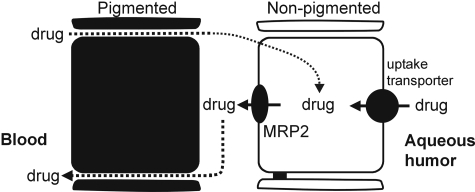Fig. 7.
Model depicting the proposed barrier and absorptive roles for MRP2 in xenobiotic transport by the NPE of the ciliary body. The proposed barrier role played by MRP2 is as follows. Xenobiotics (hydrophobic) diffuse out of the fenestrated ciliary body capillaries and between (or across) the pigmented epithelial cells, which do not contain tight junctions. Apically located MRP2 could prevent these xenobiotics from accumulating inside NPE cells and the aqueous humor by actively pumping the drugs back into the paracellular space between the pigmented and NPE cells. According to the absorptive model, xenobiotics (hydrophilic) originating inside the eye could be taken up across the basolateral membrane by uptake transporters (possibly the OATPs). MRP2 in the apical membrane of the NPE could prevent the intracellular accumulation of these drugs by pumping them into the paracellular space between the pigmented and NPE cells.

